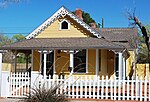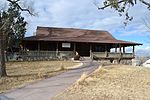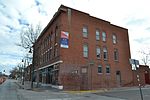Huning Highlands Conoco Service Station

The Huning Highlands Conoco Service Station is a historic gas station in the Huning Highlands neighborhood of Albuquerque, New Mexico. It was built in 1937 by the Continental Oil Company (Conoco) and is notable as a well-preserved example of the automobile-oriented development that shaped the city during the mid-20th century. The building was listed on the New Mexico State Register of Cultural Properties and the National Register of Historic Places in 2006.The service station is built in the form of a cottage, a popular design at the time, with a steeply pitched compound gable roof and a chimney. The walls are white glazed brick with green trim. The building has a side-gabled office section on the west side adjoining two front-gabled garage bays with wooden roll-up doors. The easternmost garage bay was an addition built onto the original station around 1939. The property also includes concrete gas pump islands, a c. 1960s light pole and a steel sign post, though the pumps, tanks, and signage have been removed. The station was operated by Conoco until 1961, then by Horn Oil Company until around 1983. In 1992, the vacant station was leased by the Albuquerque Conservation Association (TACA), which uses the building as headquarters for its preservation workshops and other activities.
Excerpt from the Wikipedia article Huning Highlands Conoco Service Station (License: CC BY-SA 3.0, Authors, Images).Huning Highlands Conoco Service Station
Silver Avenue Southeast, Albuquerque Downtown Albuquerque
Geographical coordinates (GPS) Address Nearby Places Show on map
Geographical coordinates (GPS)
| Latitude | Longitude |
|---|---|
| N 35.081111111111 ° | E -106.64166666667 ° |
Address
Silver Avenue Southeast
Silver Avenue Southeast
87102 Albuquerque, Downtown Albuquerque
New Mexico, United States
Open on Google Maps








